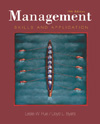 |  Management: Skills and Application, 10/e Leslie W Rue,
Georgia State University - Emeritus
Lloyd L Byars,
Georgia Institute of Technology
Operations Management and Planning
Chapter Summary1. Define operations management. Operations management is the application of the basic concepts and principles of management to those segments of the organization that produce its goods or services.
2. Describe an operating system, and identify the two basic types of operating systems. An operating system consists of the processes and activities necessary to transform various inputs into goods and/or services. The two basic types of operating systems are those based on continuous flows and those based on intermittent flows. Continuous flow systems generally have a standardized product or service. Intermittent flow systems usually produce customized products and services.
3. Differentiate among product/service design, process selection, and site selection decisions. Product/service design decisions deal with how the product or service will be designed. The design must be such that it can be economically produced. Process selection includes a wide range of decisions concerning the specific process to be used, the basic sequences of the process, and the equipment to be used. Site selection decisions are concerned with where to locate a new or an additional facility.
4. Explain what a materials-handling system is. A materials-handling system is the entire network that receives materials, stores materials, moves materials between processing points and between buildings, and positions the final product or service for delivery to the ultimate customer.
5. Describe and give an example of the three basic classifications of facilities layouts. The three basic types of layouts are process layouts, product layouts, and fixed-position layouts. With a process layout, equipment or services of a similar functional type are arranged or grouped together. Custom fabrication shops and hospitals are examples of organizations that use process layouts. With a product layout, the equipment or services are arranged according to the progressive steps by which the product is made or the customer is serviced. Automobile assembly plants and cafeterias are examples of organizations that use product layouts. With a process layout, equipment or services of a similar functional type are arranged or grouped together. Custom fabrication shops and hospitals are examples of organizations that use process layouts. With a fixed-position layout the product is too large to move and remains in place. Manufacturing of very large products such as ships or airplanes use the fixed-position layout.
6. Explain the sociotechnical approach to job design. The sociotechnical approach to job design considers not only the technical system and the task to be done but also the accompanying social system.
7. Describe several computer-related technologies that are currently playing major roles in production/operations management. Computer-aided design (CAD) is used in product design to generate various views of different components and assemblies. Computer-aided engineering (CAE) uses a product's characteristics to analyze its performance under different parameters. Computer-aided manufacturing (CAM) uses stored data regarding various products to provide instructions for automated production equipment.
Computer-integrated manufacturing (CIM) uses computer technology to incorporate all of the organization's production-related functions into an integrated computer system to assist, augment, or automate most operations.
8. Outline the three major steps in developing an aggregate production plan. The first step in developing an aggregate production plan is to obtain a demand forecast for the organization's goods or services. The second step involves evaluating the impact of the demand forecasts on the organization's resources. The third step is to develop the best plan for using the organization's current and expected resources to meet the forecast demand.
9. Summarize the differences between resource allocation and activity scheduling. Resource allocation is concerned with the efficient allocation of people, materials, and equipment to meet the demand requirements of the operating system. This includes distributing the workload and determining how much time should be allotted for each stage in the production process. Activity scheduling develops the precise timetable to be followed when producing the product or service. Activity scheduling does not involve determining how long a job will take; rather, it determines when the work is to be done.
10. Distinguish among Gantt charts, the critical path method (CPM), and the program evaluation and review technique (PERT). Gantt charts graphically depict work planned and work accomplished in relation to time. CPM and PERT both result in a network representation of a project or a group of activities. CPM and PERT have two distinct advantages over Gantt charts: (1) The interdependencies of the activities are noted explicitly, and (2) the activities are shown in greater detail. The major difference between CPM and PERT centers around activity time estimates. CPM is used for projects whose activity durations are accurately known. PERT is used when the activity durations are more uncertain and variable. |
|



 2003 McGraw-Hill Higher Education
2003 McGraw-Hill Higher Education